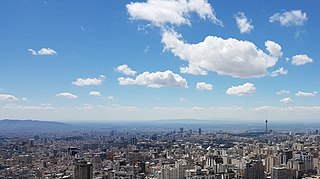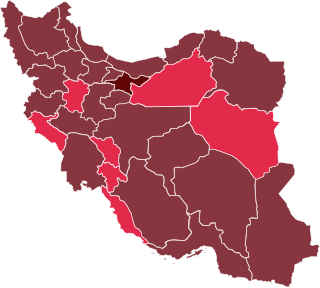| Jameh Mosque of Marandiz | |
|---|---|
 | |
| Religion | |
| Affiliation | Islam |
| Province | Razavi Khorasan Province |
| Location | |
| Location | |
| Architecture | |
| Type | Mosque |
| Completed | Ilkhanate |
The Jameh Mosque of Marandiz is related to the Ilkhanate and is located in the Marandiz. [1] [2]
| Jameh Mosque of Marandiz | |
|---|---|
 | |
| Religion | |
| Affiliation | Islam |
| Province | Razavi Khorasan Province |
| Location | |
| Location | |
| Architecture | |
| Type | Mosque |
| Completed | Ilkhanate |
The Jameh Mosque of Marandiz is related to the Ilkhanate and is located in the Marandiz. [1] [2]
| This article about a mosque or other Islamic place of worship in Iran is a stub. You can help Wikipedia by expanding it. |

The Baháʼí Faith is a religion teaching the essential worth of all religions, and the unity of all people. Established by Baháʼu'lláh in 1863, it initially grew in Persia and parts of the Middle East, where it has faced ongoing persecution since its inception. It is estimated to have between 5 and 8 million adherents, known as Baháʼís, spread throughout most of the world's countries and territories.

Persian, also known by its endonym Farsi, is a Western Iranian language belonging to the Iranian branch of the Indo-Iranian subdivision of the Indo-European languages. It is a pluricentric language predominantly spoken and used officially within Iran, Afghanistan and Tajikistan in three mutually intelligible standard varieties, namely Iranian Persian, Dari Persian and Tajiki Persian. It is also spoken natively in the Tajik variety by a significant population within Uzbekistan, as well as within other regions with a Persianate history in the cultural sphere of Greater Iran. It is written officially within Iran and Afghanistan in the Persian alphabet, a derivation of the Arabic script, and within Tajikistan in the Tajik alphabet, a derivation of Cyrillic.

Iran, also called Persia, and officially the Islamic Republic of Iran, is a country in Western Asia. It is bordered to the northwest by Armenia and Azerbaijan, to the north by the Caspian Sea, to the northeast by Turkmenistan, to the east by Afghanistan and Pakistan, to the south by the Persian Gulf and the Gulf of Oman, and to the west by Turkey and Iraq. Its central location in Eurasia and proximity to the Strait of Hormuz give it significant geostrategic importance. Tehran is the capital and largest city, as well as the leading economic and cultural hub; it is also the most populous city in Western Asia, with more than 8.8 million residents, and up to 15 million including the metropolitan area. With 83 million inhabitants, Iran is the world's 17th most populous country. Spanning 1,648,195 km2 (636,372 sq mi), it is the second largest country in the Middle East and the 17th largest in the world.

The Iran–Contra affair, popularized in Iran as the McFarlane affair, the Iran–Contra scandal, or simply Iran–Contra, was a political scandal in the United States that occurred during the second term of the Reagan Administration. Senior administration officials secretly facilitated the sale of arms to the Khomeini government of the Islamic Republic of Iran, which was the subject of an arms embargo. The administration hoped to use the proceeds of the arms sale to fund the Contras in Nicaragua. Under the Boland Amendment, further funding of the Contras by the government had been prohibited by Congress.

The Iran–Iraq War was a protracted armed conflict that began on 22 September 1980 when Iran was invaded by neighbouring Iraq. The war lasted almost eight years, ending in a stalemate on 20 August 1988 when Iran accepted a UN-brokered ceasefire. Iraq's rationale for the invasion was primarily to cripple Iran and prevent Ayatollah Ruhollah Khomeini from exporting the 1979 Iranian Revolution movement to Shia-majority Iraq and threaten the Sunni-dominated Ba'athist leadership. Iraq had also wished to replace Iran as the dominant state in the Persian Gulf, which had not been previously possible due to pre-revolutionary Iran's goliath status in both economic and military terms as well as its close alliances with the United States and Israel. The war followed a long-running history of border disputes, as a result of which Iraq had planned to annex Iran's oil-rich Khuzestan Province and the east bank of the Shatt al-Arab.
The Persians are an Iranian ethnic group that make up over half the population of Iran. They share a common cultural system and are native speakers of the Persian language, as well as languages closely related to Persian.

Sayyid Ruhollah Musavi Khomeini, also known in the Western world as Ayatollah Khomeini, was an Iranian politician, revolutionary, and cleric. He was the founder of the Islamic Republic of Iran and the leader of the 1979 Iranian Revolution, which saw the overthrow of the last Shah of Iran, Mohammad Reza Pahlavi, and the end of the 2,500-year-old Persian monarchy. Following the revolution, Khomeini became the country's Supreme Leader, a position created in the constitution of the Islamic Republic as the highest-ranking political and religious authority of the nation, which he held until his death. He was succeeded by Ali Khamenei on 4 June 1989.
Zoroastrianism or Mazdayasna is one of the world's oldest continuously practiced religions. It is a multi-faceted faith centered on a dualistic cosmology of good and evil and an eschatology predicting the ultimate conquest of evil with theological elements of henotheism, monotheism/monism, and polytheism. Ascribed to the teachings of the Iranian-speaking spiritual leader Zoroaster, it exalts an uncreated and benevolent deity of wisdom, Ahura Mazda, as its supreme being. Historical features of Zoroastrianism, such as messianism, judgment after death, heaven and hell, and free will may have influenced other religious and philosophical systems, including Second Temple Judaism, Gnosticism, Greek philosophy, Christianity, Islam, the Bahá'í Faith, and Buddhism.

Tehran is the capital of Iran and Tehran Province. With a population of around 8.7 million in the city and 15 million in the larger metropolitan area of Greater Tehran, Tehran is the most populous city in Iran and Western Asia, and has the third-largest metropolitan area in the Middle East. It is ranked 24th in the world by the population of its metropolitan area.

The Imperial State of Iran, also known as the Imperial State of Persia from 1925 to 1935, was a country in Western Asia. It was ruled by the Pahlavi dynasty, the last ruling house of Iran, from 1925 until 1979, when the Persian monarchy was overthrown and abolished as a result of the Islamic Revolution. The dynasty was founded by Reza Shah Pahlavi in 1925, a former brigadier-general of the Persian Cossack Brigade, whose reign lasted until 1941, when he was forced to abdicate by the Allies after the Anglo-Soviet invasion of Iran. He was succeeded by his son, Mohammad Reza Pahlavi, the last Shah of Iran.

The Iranian Revolution was a series of events that culminated in the overthrow of the Pahlavi dynasty under Shah Mohammad Reza Pahlavi—who was supported by the United States—and the replacement of his government with an Islamic republic under the Grand Ayatollah Ruhollah Khomeini, a leader of one of the factions in the revolt. The revolution was supported by various Islamist and leftist organizations and student movements.

Sayyid Ali Hosseini Khamenei is a Twelver Shia Marja' and the second and current Supreme Leader of Iran, in office since 1989. He was previously President of Iran from 1981 to 1989. Khamenei is the longest serving head of state in the Middle East, as well as the second-longest serving Iranian leader of the last century, after Shah Mohammad Reza Pahlavi.

Mahmoud Ahmadinejad, born Mahmoud Sabbaghian, is an Iranian politician who served as the sixth President of Iran from 2005 to 2013. He was also the main political leader of the Alliance of Builders of Islamic Iran, a coalition of conservative political groups in the country, and served as mayor of Tehran from 2003 to 2005.

The Iranian peoples or the Iranic peoples, are a diverse Indo-European ethno-linguistic group.

Mohammad Reza Pahlavi, also known as Mohammad Reza Shah, was the last Shah (King) of Iran from 16 September 1941 until his overthrow in the Iranian Revolution on 11 February 1979. Due to his status as the last Shah of Iran, he is often known as simply the Shah.

The Persian Empire or Imperial Iran is any one of the many imperial dynasties centred in Iran (Persia) from the 6th century BC, the Achaemenid Empire, to the 20th century, the Pahlavi dynasty.

"Aryan" has its roots as a term used as a self-designation by Indo-Iranian people. The term was used by the Indo-Aryan people of the Vedic period in Ancient India as a religious label for themselves and as well as the geographic region known as Āryāvarta, where Indo-Aryan culture is based. The Iranian people used the term as an ethnic label for themselves in the Avesta scriptures, and the word forms the etymological source of the country name Iran.

Marandiz is a village in Yunesi Rural District, Yunesi District, Bajestan County, Razavi Khorasan Province, Iran. At the 2006 census, its population was 2,668, in 678 families.

Marandiz is a village in Sahra Rural District, Anabad District, Bardaskan County, Razavi Khorasan Province, Iran. At the 2006 census, its population was 651, in 162 families.

The COVID-19 pandemic in Iran is part of the worldwide pandemic of coronavirus disease 2019 caused by severe acute respiratory syndrome coronavirus 2. On 19 February 2020, Iran reported its first confirmed cases of infections in Qom. The virus may have been brought to the country by a merchant from Qom who had travelled to China.